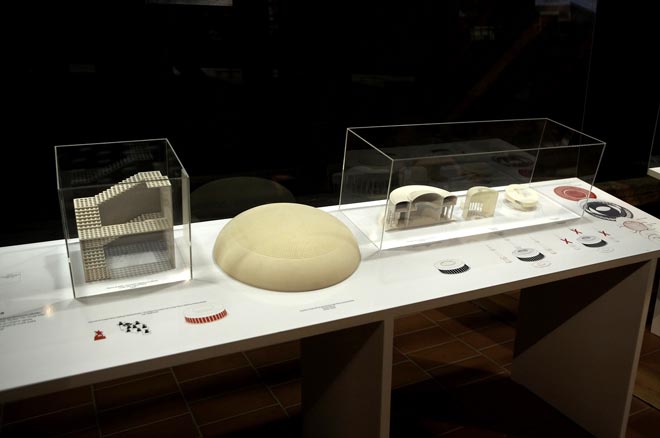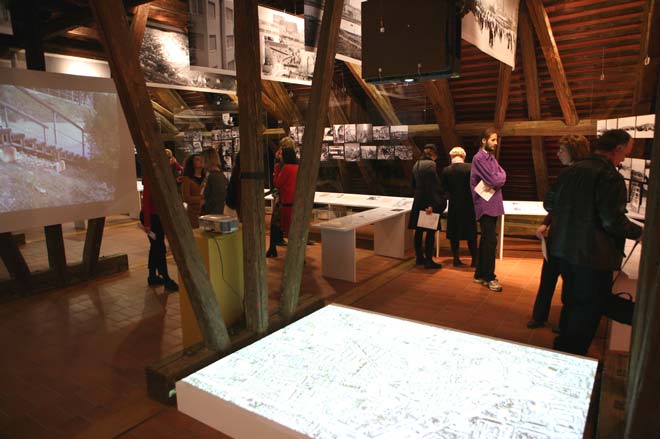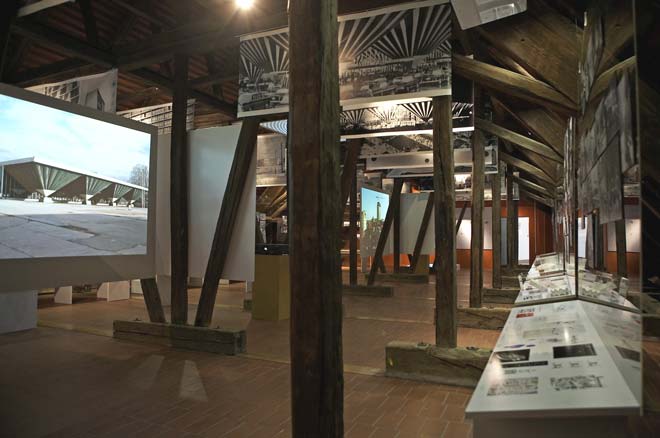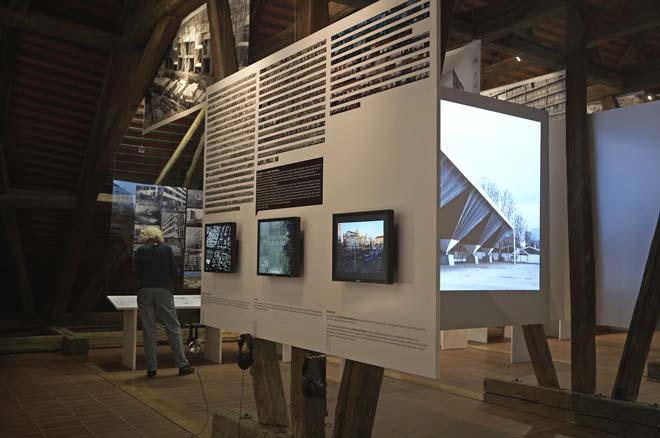Project Zagreb: Transition as Condition-Strategy-Practice
Harvard University, Graduate School of Design, guest appearance in Zagreb City Museum
Exhibition concept: Eve Blau, Ivan Rupnik
Multimedia: Bruno Bahunek
Exhibition design: Ivan Rupnik
Coordinator: Hela Vukadin-Doronjga, ZCM
Poster design: Ivan Kraljević

The exhibition has derived from the book of the same name, and epitomises the whole of the content. Comparing the two – the book and the exhibition, it is at once apparent that the exhibition is a visualised medium, that in today's interpretation, using all the capacities of contemporary technology, from the point of view of the reception of the desired message, has, in its form and substance, a much stronger and more direct effect on the visitor. All the elements and the scholarly interpretation within the framework of this research, at the exhibition, are reduced to a basic code, behind which remains the book, there so that the visitor, now the reader, should be able to become more deeply familiar with the content that this topic relates.
There are a number of reasons why we urged that the exhibition Project Zagreb should be mounted precisely in Zagreb City Museum. Above all because the thematic emphasis is upon Zagreb and the exhibition has achieved to date a very marked success in Harvard University. The exhibition is mobile, and after the Zagreb premiere will be able to go on its world tour.
Exploring the rich archival material (part of which has not previously been made public), evaluated in the framework of the scholarly and expert work, the innovative, fresh, contemporary, original and unconventional approach to the understanding and interpretation of the relationships of cause and effect in the development and shaping of the space – the identity of a modern town, became to be seen as a basic.
The multidisciplinary manner of thinking imparts a particular value to the project, in the way that it turns over the living processes of transformations and transitions: cultural, ideological, political, sociological, economic, technological and their manifestations and implementation in urban planning and architectural form, and in the registration, representation and understanding of their logic and dynamics.
 In addition, thanks to the method of work and the manner of elaborating the material, the exhibition bears witness to the quality of the discipline of architecture (this refers in particular to the graphic and visual presentation of the materials: the abstract diagrams, the orthophotographs and other photographs, the maps of the city, with the symbolic and interesting graphic interventions on them; the drawings and spatial representations and so on). We would in particular pick out the diagrams, interesting visual presentation of the results of research (at the same time, they have enabled the very capacious contents of the research to be pared down to the minimum).
In addition, thanks to the method of work and the manner of elaborating the material, the exhibition bears witness to the quality of the discipline of architecture (this refers in particular to the graphic and visual presentation of the materials: the abstract diagrams, the orthophotographs and other photographs, the maps of the city, with the symbolic and interesting graphic interventions on them; the drawings and spatial representations and so on). We would in particular pick out the diagrams, interesting visual presentation of the results of research (at the same time, they have enabled the very capacious contents of the research to be pared down to the minimum).
In what has been to date a situation only partially explored, the Harvard architects and architecture historians have introduced propositions and conclusions in a different, more liberal, view than has been the case to date (everything has so far been thought of through the ideas of the left), attempting to respond to the issue, and starting off from the assumption: "Zagreb was created by modernity, and formed by the political transition. Has the permanent condition of transition of modern Zagreb created a new technique for the creation of a city?"
The modernisation processes in Zagreb over the last 150 years have been researched and presented at the exhibition as separate chapters or case studies at three levels of presentation (photographs; graphic displays/diagrams and 3D models; films), simulating the different realities of planning, of the transformation of the space (we can see at the same time the built and the virtual reality; the developed and the undeveloped space).
Pulling together the separate cases, the exhibition is a simulation of the city, and the emphasis is put on transitional situations (politically unstable and uncertain), which are turned into cases, and thus generate practice (it is not the history of the city as such that is importance, as much as innovation in approach): our object in Project Zagreb is to understand the dynamics of practice, and not to show the history of Zagreb. Chronological monitoring enables us to see the way in which these practices have developed within this context (Ivan Rupnik).
 A special emphasis at the exhibition is placed on films. Looking at them from the experiential aspect, it is fundamental that they enable additional, more communicative, more dynamic views of the city (put in the centre of the space, they are projected onto several large vertical forex screens). Films, from special and temporal fragments of the transition, construct several possible parallel Zagrebs (they themselves create cities). As pieces by specific authors with subjective agendas, they function as a parallel Project Zagreb; as virtual urban planning projects, through comparison they tell of a possible perception of the city as "open city".
A special emphasis at the exhibition is placed on films. Looking at them from the experiential aspect, it is fundamental that they enable additional, more communicative, more dynamic views of the city (put in the centre of the space, they are projected onto several large vertical forex screens). Films, from special and temporal fragments of the transition, construct several possible parallel Zagrebs (they themselves create cities). As pieces by specific authors with subjective agendas, they function as a parallel Project Zagreb; as virtual urban planning projects, through comparison they tell of a possible perception of the city as "open city".
The short stop-frame sections are parts of the documentary film Project Zagreb (by Bruno Bahunek), but are directed according to the "practices/case studies" from the book of the same name, projecting them inside the space and time of the contemporary city (as reconstructions of them, i.e., some potential manner that these spaces might be).
In the photographs we can read off the development of the city over time, "the biological changes and genesis of these spaces", as they have changed profoundly over the course of time. Placed in groups on great vertical Perspex surfaces, they are intended to be seen as a unit. According to the criteria for presentation, the attempt has been made, as well as to their artistic, to draw attention to something of their documentary value. This means looking at the architecture in the context of the space as a whole, where people, their existence and everyday life are the dominants.
Unlike the diagrams, the least immediately communicative medium at the exhibition, which seek deep reading and a greater commitment, photographs conjure up for us the bustle and then the emptiness of the Zagreb streets and squares. The adverts on the fronts of buildings, the cars in fashion, the accidentally captured passers-by document the time, the fashion, sketching out the suggestive atmosphere of the city. With the help of them we can read off the ideologies, political views, the constraints upon planning.
Finally, the dialogue between research and practice in Project Zagreb is shown through a number of contemporary designs of Zagreb architects and planners, shown in the exhibition within the framework of the last case studies: Outlines of metropolis: transition as practice; and Zagreb 2000+: urban rules. These projects preserve the city from the constructional whimsies of private owners, sense some perspectives of a future manner of planning Zagreb, position us where we are today, while starting from the idea that there can be no innovation without the awareness that "practice, lasting processes and multiplicity of logics" are the foundation of designing.
If the exhibition, a historical and culture studies project, has enabled a visual impression of the deep importance of the links of cause and effect between development and design and transformation of the space and the dynamics of the modernisation processes of Zagreb during the 20th century and beyond, then from the show it is possible to comprehend all round the elements, logics and mechanisms of the "city as open work".
Hela Vukadin-Doronjga
Pictures from the exhibition









photo Miljenko Gregl, ZCM
 Exhibition catalogue
Exhibition catalogue
Blau, Eve; Ivan Rupnik; Hela Vukadin-Doronjga. Project Zagreb : Transition as condition - strategy - practice.
Zagreb : Zagreb City Museum, 2008

